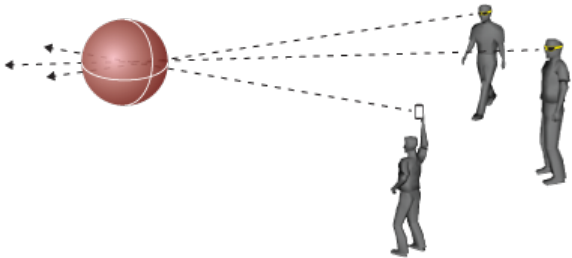Crowd-activated Google Hangout On Air broadcasts
September 23, 2013
“What you see is one person who is filming a video, and then the other person is able to join that video stream just by looking at it.” — Jon Fisher
This just in from CrowdOptic CEO Jon Fisher, live at the RocketSpace Glass Hackathon in San Francisco, where his team just demo’d CrowdOptic’s new Android app for social sharing: crowd-activated Google Hangout On Air (live video broadcasting on a Google Hangout).
The new app (still in beta) runs on smartphones and wearable computing devices such as Google Glass. Instead of one person launching an On Air broadcast, the new app uses group focus (what multiple people are looking at) around a shared moment or common point of interest to launch Hangout On Air.
“You can now start or join a video stream just by looking at it,” Fisher says.
“A shared moment can be a predetermined event—such as a live concert or sporting event—or even a spontaneous gathering (e.g., a breaking news event such as a fire). The common points of focus around such events represent significant moments ideally suited for broadcasting via Google+ Hangout On Air.”
How it works
Conventional Google Hangout on Air
When a crowd’s collective focus has been detected, CrowdOptic invites those Android users who are focused on the same point of interest to start a Hangout On Air (HOA). The first Android user to initiate the HOA becomes the HOA’s moderator.
Additional Android users (on Glass or smartphones) can join the ongoing HOA simply by focusing on the same point of interest. And Android users who have joined the HOA can share in the collective moment by broadcasting their own viewpoint, or by seeing the view of another user with a different vantage point.
What is CrowdOptic?
[+]
CrowdOptic is a patented technology
(U.S. Patent No. 8,527,340) that uses sensor data from electronic
devices and archival media file metadata to calculate user sightlines
and sightline intersections.
Multiple users form focal “clusters” (credit: Crowdoptic)
Significant groups of these intersections, called focal “clusters,” represent the collective focus of a group of people (not merely a single person).
Focal clusters, which change dynamically with the changing nature of a group or crowd’s attention, can be used as the activation point for any number of apps that seek to engage groups of users in the context of what they are all collectively witnessing.
Such context-aware applications can leverage CrowdOptic’s numerous focal data attributes, including location of focus, number of viewers, distance to epicenter, timestamp, and “heat index.” Profiles of users “in the cluster” and crowdsourced comments, photos, and videos can also control the HOA activation.
(¯`*• Global Source and/or more resources at http://goo.gl/zvSV7 │ www.Future-Observatory.blogspot.com and on LinkeIn Group's "Becoming Aware of the Futures" at http://goo.gl/8qKBbK │ @SciCzar │ Point of Contact: www.linkedin.com/in/AndresAgostini
 Washington
Washington